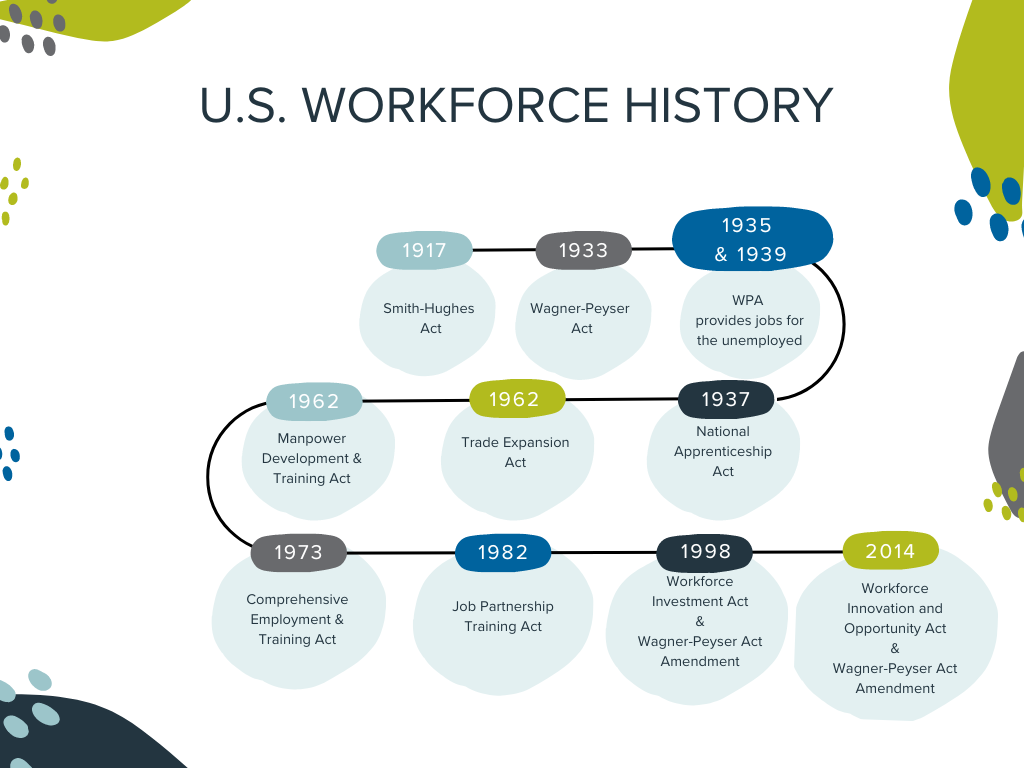27 Jul The History of Workforce Development in the U.S.
 The United States of America is one of the leading economies in the world, which is largely attributed to its expansive, diverse, and skilled workforce. Federal, state, and local governments have made significant investments in workforce development to ensure that the nation’s labor force is competitive and equipped with the skills needed to succeed in a modern economy. Discover the history of workforce development in the United States and examine the impact of our nation’s laws as well as the importance of local workforce boards in the economic development of local communities.
The United States of America is one of the leading economies in the world, which is largely attributed to its expansive, diverse, and skilled workforce. Federal, state, and local governments have made significant investments in workforce development to ensure that the nation’s labor force is competitive and equipped with the skills needed to succeed in a modern economy. Discover the history of workforce development in the United States and examine the impact of our nation’s laws as well as the importance of local workforce boards in the economic development of local communities.
Vocational Education in High Schools Begins
The United States has a long history of workforce development laws, dating back to the early 20th century. The first significant law was the Smith-Hughes Act of 1917, which provided federal funding for vocational education in high schools. This law was enacted to address the needs of a rapidly changing economy, which required a skilled workforce to operate the new machines and technologies of the industrial revolution.
Job Seeker and Employer Connection Services are Formed
The Great Depression left a devastating impact on the working class between 1929 and 1939. Many were laid off from work or sought career advancement opportunities to earn a livable wage. According to the Bureau of Labor Statistics, approximately one-fourth of the United States labor force or over 2.8 million individuals were facing unemployment in 1933. In response, the Wagner-Peyser Act of 1933 was established to help connect job seekers with employment opportunities.
The Act was amended to expand employment service offerings, such as skills training and career pathways coaching, under the Workforce Investment Act (WIA). In 2014, the Act was amended a second time in accordance with Title III of the Workforce Innovation and Opportunity Act (WIOA) to collocate employment services in over 2,500 American Job Centers and enact accountability measures.
The WPA Hires Job Seekers to Restore the Nation
With a 20% unemployment rate in 1935, President Franklin D. Roosevelt developed the Works Progress Administration (WPA) in 1935 by executive order. The WPA was designed to provide jobs for job seekers who struggled to find work. By 1938, an estimated 3.3 million individuals were employed by the WPA.
In 1939, the WPA was renamed the Work Projects Administration and was tasked with using unemployed workers to build or restore America’s public works infrastructure. Examples of projects include new or renovated schools, hospitals, storm drains, and roadways. The WPA also employed workers to plant 24 million trees following the Dust Bowl of the 1930s where a severe drought destroyed farmlands in the Great Plains.
Apprenticeships Training Programs Offer Hands-On Experience
The next major workforce development law was the National Apprenticeship Act of 1937, which established the framework for the modern apprenticeship system. The Act provided a legal basis for employers to establish and operate apprenticeship programs. The Office of Apprenticeship was created within the U.S. Department of Labor to oversee these programs.
Skills Training Assistance Programs are Initiated
The Trade Adjustment Assistance program was created in 1962 as part of the Trade Expansion Act to provide assistance to workers who lose their jobs due to increased imports. The program was designed to help these workers find new employment opportunities and receive training to upgrade their skills.
Under TAA, eligible workers receive a range of services, including job search assistance, career counseling, training and education, and income support. TAA also provides wage subsidies to employers who hire TAA-eligible workers and allows for the provision of relocation and transportation assistance.
In 1962, the Manpower Development and Training Act (MDTA) was passed, which provided federal funding for the training and retraining of workers to meet the needs of a changing economy. The MDTA was later replaced by the Comprehensive Employment and Training Act (CETA) in 1973, which provided job training and employment assistance to low-income individuals and displaced workers. CETA was repealed in 1982 and replaced by the Job Training Partnership Act (JTPA), which expanded the scope of workforce development programs to include dislocated workers and other populations in need.
A National Workforce Development System is Established
As previously mentioned with the Wagner-Peyser Act, the Workforce Investment Act (WIA) was enacted in 1998. This Act reauthorized and expanded the JTPA. The WIA created a national workforce development system that included state and local workforce investment boards, which were responsible for developing and implementing local workforce development plans. The WIA also established the One-Stop Career Center system, which provided a one-stop-shop for job seekers to access employment and training services.
WIA Evolves Into WIOA
In 2014, the Workforce Innovation and Opportunity Act (WIOA) replaced the WIA. The WIOA strengthened the role of local workforce boards in workforce development and emphasized the need for collaboration among stakeholders in the workforce development system. The WIOA also placed a greater emphasis on industry-led partnerships and sector-based strategies to ensure that training programs were aligned with the needs of employers. The Act defines and authorizes employment services within five titles.
- Title I – Workforce Development Activities
-
- States the workforce development boards are authorized to fund, oversee, and hold accountable selected providers who offer skills training and supportive services to the unemployed and underemployed
-
- Title II – Adult Education and Literacy
-
- Authorizes services for adults in need of a fundamental level of education as well as those who are completing their secondary education or transitioning to post-secondary education
-
- Title III – Amendments to the Wagner-Peyser Act
-
- Integrates the United States Employment Services (ES) into the nation’s One-Stop Career Centers
-
- Title IV – Amendments to the Rehabilitation Act of 1973
-
- Ensures individuals with disabilities have access to vocational rehabilitation services in the One-Stop Career Centers
-
- Title V – General Provisions
-
- Defines the transitional changes from WIA to WIOA
-
Timeline of Workforce Development in the United States

The Importance of Local Workforce Boards
Local workforce boards play a critical role in the economic development of local communities. These boards are composed of representatives from the public and private sectors, including employers, labor unions, community-based organizations, and education and training providers. Local workforce boards are responsible for developing and implementing local workforce development plans that are tailored to the needs of the local economy.
Local workforce boards have a deep understanding of the local labor market and the skills and training needed to meet the needs of employers. They work closely with employers to identify skill gaps and develop training programs that prepare workers for in-demand occupations. Local workforce boards also work with education and training providers to ensure that training programs are aligned with the needs of employers.
Local workforce boards also play a key role in promoting economic development in their communities. By working with employers and other stakeholders in the community, local workforce boards can identify emerging industries and occupations and develop strategies to prepare workers for these jobs. This can help to attract new businesses and industries to the community, which can create new job opportunities and promote economic growth.
In addition to their role in promoting economic development, local workforce boards also play an important role in addressing economic inequality. By focusing on training programs and services for low-income individuals and other underserved populations, local workforce boards can help to reduce economic disparities and promote greater equity in the labor market.
Conclusion
The history of workforce development in the United States is a testament to the importance of investing in the skills and training of the nation’s workforce. From the Smith-Hughes Act to the Workforce Innovation and Opportunity Act, these laws have evolved over time to address the changing needs of the economy and ensure that workers are equipped with the skills they need to succeed.
Local workforce boards play a critical role in the success of the workforce development system. By working with employers and other stakeholders in the community, local workforce boards can develop and implement workforce development plans that are tailored to the needs of the local economy. By overseeing the operation of the One-Stop Career Center system, local workforce boards can ensure that job seekers have access to the services they need to secure employment and advance their careers.
As the United States continues to face economic challenges and technological advancements, workforce development will remain a critical priority. By continuing to invest in the skills and training of the nation’s workforce and by promoting the role of local workforce boards in economic development, the United States can ensure that its workforce remains competitive and resilient in the global economy.
Sources
The Workforce Innovation and Opportunity Act and the One-Stop Delivery System: Congress.gov.
Works Progress Administration: History.com.
Chapter 5: Americans in Depression and War: U.S. Department of Labor.


